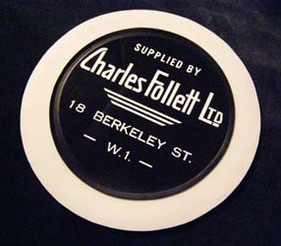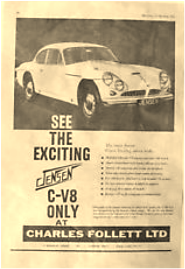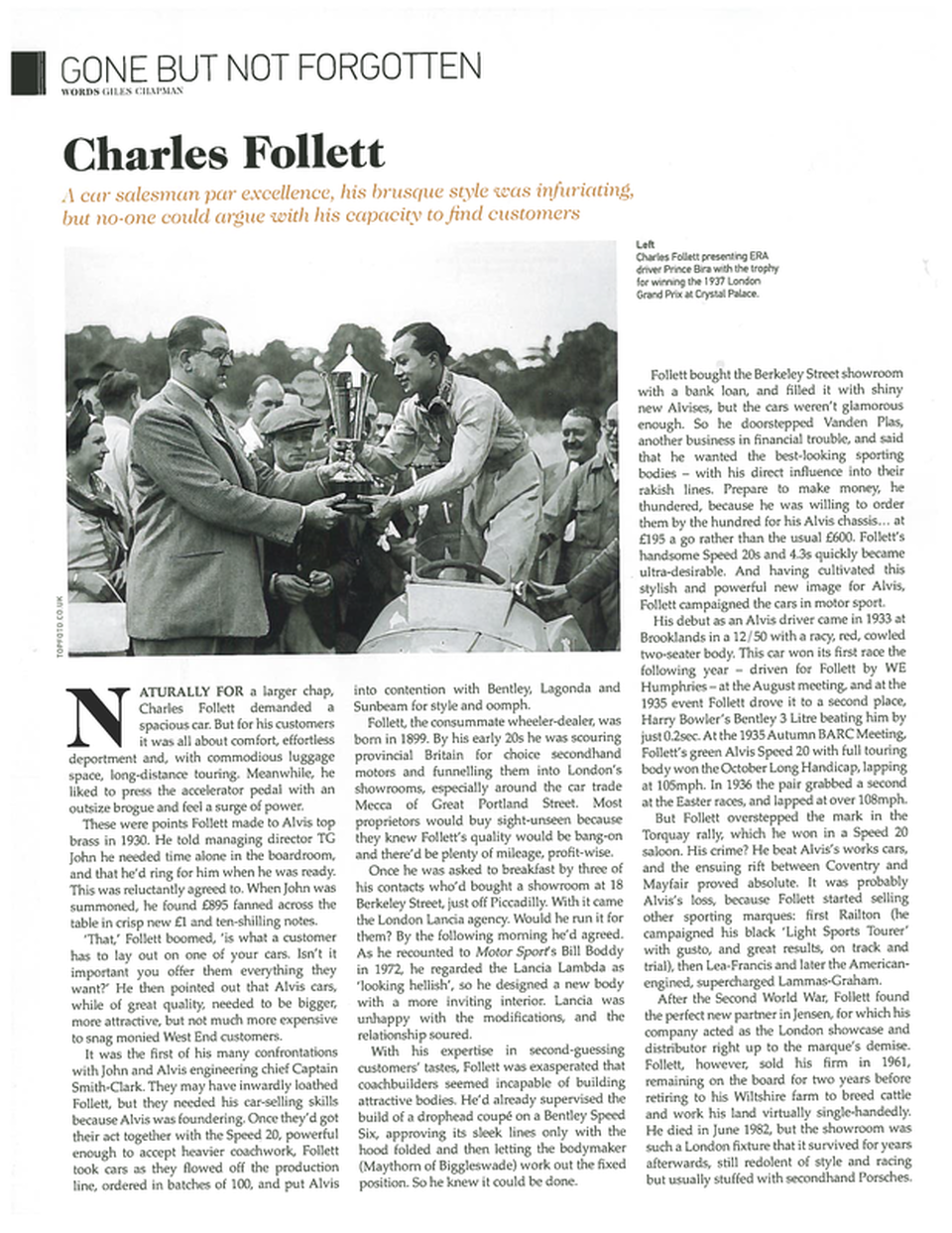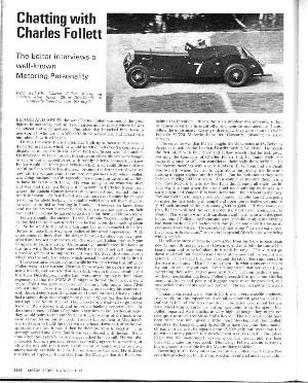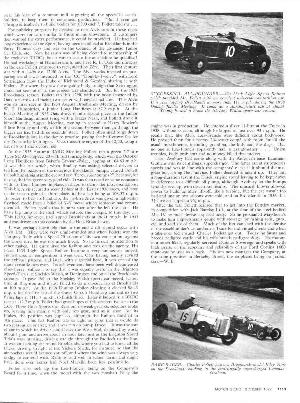Charles Follett in London supplied many CV-8s
|
Charles Follet was a well known dealer, racing driver and all round enthusiast. He became a Jensen dealer and was responsible for most of the sales in the London area. My car was sold to Morris Jackson by Charles. In a recent issue of Octane Magazine (October:2014) the sad death of Charles Follett was recorded and there was an article on his life history. I am pleased that my car has yet another illustrious motoring connection and I have included the article from Octane below. Motorsport also ran an article on Charles back in 1972 and the text from that can also be found below. Please click on any of the logos to subscribe to Octane Magazine or Motorsport. The picture in the header of this page is the Charles Follett dealer plate attached to my Jensen
C-V8. There is one on each side positioned on top of the sills. |
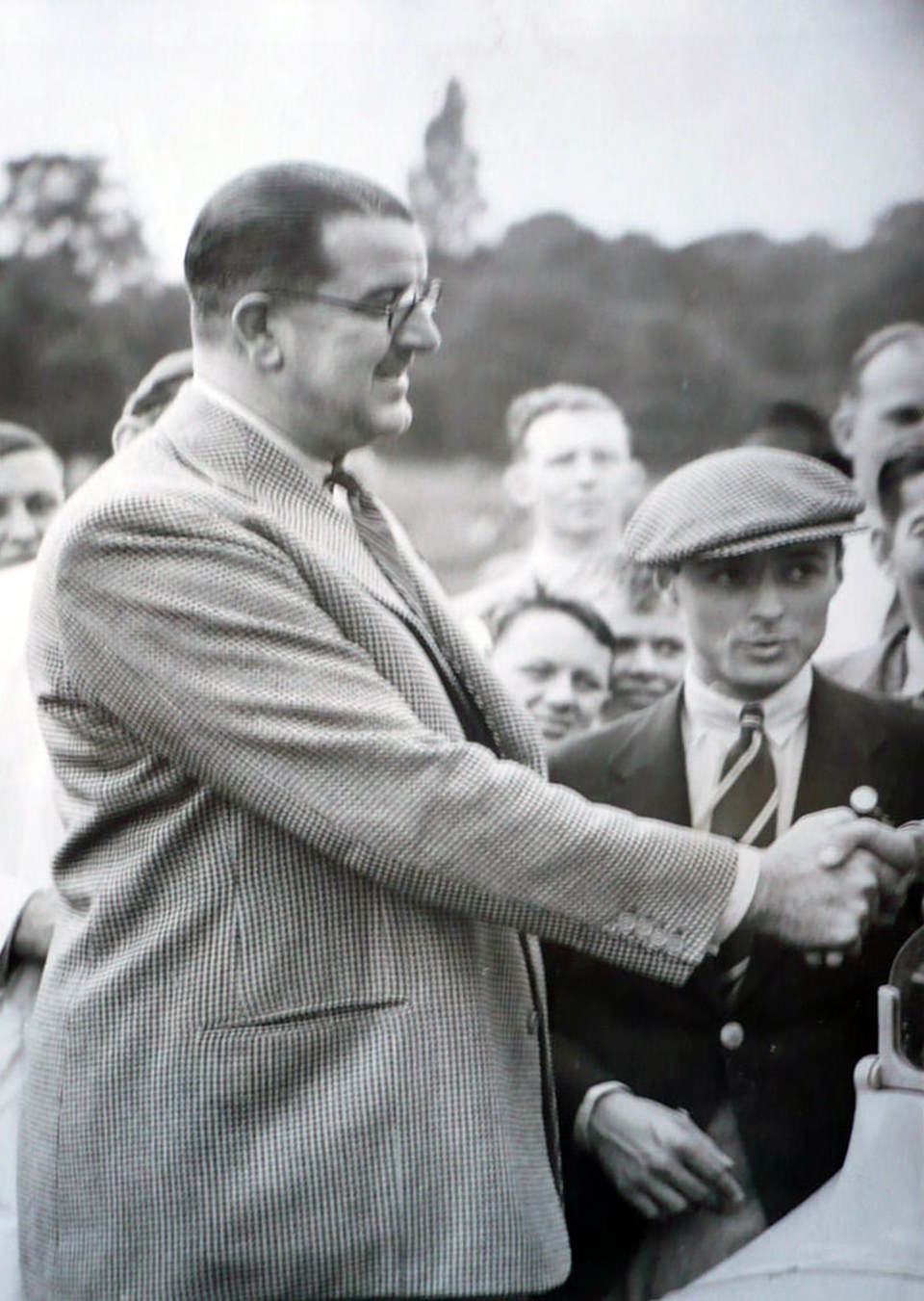
I found the above picture of Charles Follett online taken moments after the picture in the previous article above. Picture was taken in1937 in France.
|
You can download the above article in pdf format here:
The Charles Follet article below is from the 1972 edition of Motorsport. Click on the pages on the right to go to the actual article at Motorsport Magazine.
| ||||||||
Page 34, October 1972 - Chatting with Charles Follett
The Editor interviews a well-known Motoring Personality
BEFORE AND AFTER the war Charles Follett was one of the great figures in motoring, both in Trade circles and in racing where he was an official and a competitor. The other day I tracked him down, a non-stop 74, who farms in Wiltshire in his retirement, and talked with him about how it all began.
During the early 1920s Follett had built up a lucrative business in the better used cars, which he would search out all over the country and dispose or to dealers in the Great Portland Street area of London. lie developed this to a fine art, to a situation where his cars were bought by one firm at an agreed price, with.no stipulations, because they knew Follett would sell them good vehicles which they could dispose of at a useful profit to satisfied customers. Around the latter part of what we now call the vintage years these used-car partners with whom Follett was doing business on this agreeable basis rang him up and asked him to have breakfast with them. He went along to sec what was afoot and was told they had bought a showroom in Berkeley Street from where the Lancia Concessionaire-ship operated and wanted him to run it for them. At first Follett was disinterested, because he enjoyed travelling far afield looking for suitable vehicles to sell them and had no wish to be tied to working in London. However, he knew these used-car dealers would never be able to run a new-car agency on their own and the next day he agreed to do the job for them, on his own terms.
Follett thought the current Lancia Lambda "looked hellish", and he decided that as he was to sell them, he had better do something about it. So he went to the Albany Carriage Co. and persuaded their Mr. Button to make him Weymann bodies of improved appearance. With more rounded lines than the detachable-top Lambda had ever possessed and revised dashboards, etc. the advanced Italian product began to appeal to British tastes. Unfortunately Lancia's were lumbered at the time with Sixth Series cars which they could not sell and were therefore reluctant to supply Follett with the Seventh Series chassis which was the only Lambda to which special bodywork could be fitted. This constituted a deadlock and while he was pondering this difficulty Follett went to the current Olympia Show where the dealers met their many friends, and was told that Alvis Ltd. were in financial trouble and that their Distributors, lenlys Ltd. were unwilling to pay their Show expenses, so that the SMM & T might withdraw the allocated stand space. Follett was persuaded to meet Tommy John and discuss Alvis cars with him. Now it so happened that alter severing his connection with the Berkeley Street showroom and Lancia business, Charles Follett had a special drop-head coupe body put on a Speed Six Bentley chassis for Capt. Eric Smith, then of Thom. Cooks and destined to go on the board of Rolls Royce Ltd. and important banking concerns, etc. At the time no-one, in Charles' Opinion, knew how to build a decent body; they would point to the enforced low fulcrum-point of the hood-irons as an excuse for an untidy hood. He took his problem to fvlaythom's and told them to build the body with the hood down and, after he had approved the lines, it would then be their problem to erect it. This strategy worked and Capt. Smith was very pleased with the car. Some time after this Follett's bank manager asked him to call. I-k was disinterested but as a personal favour eventually agreed to u meeting, at which he was told that a very sizeable sum of money was to be made anonymously available to him, to run a motor business. He disliked this kind of approach but dieted from the Manager that the Bank was
behind the intention. When the Alvis problem was presented to him he remembered this financial offer and rang his accountant at 2 a.m.. telling the unfortunate man to get dretsed, as they were about to leave in Follett's 36/220 Mercedes-Benz for Coventry, planning to arrive at 8 a.m.
The outcome was that Follett bought the showrooms at 18, Berkeley Street and took on the London Distributorship for Alvis. He recalls the first 14/75 with blue body and yellow wheels that he took away. Forming the Company of Charles Follett Ltd. he found Alvis cars reasonably easy to sell, but considered their body lines terrible. He had stormy meetings with a very stubborn T. 0. John and a difficult Smith-Clark whom he had to fight about improving the lines and putting a bigger engine into the Alvis. But he took cars as they were finished buying 100 in a batch. In a couple of months there was a new Speed-20 for him to try but John didn't enjoy all their hustle! This was the time when the specialised coachbuilding trade was in a sorry plight and Vanden Plas were desperate. Follett went to their Mr. Fox and told him to prepare to make money. He told him he was going to make the best-looking dh coupe and open tourer bodies yet. and at £195 each instead of the customary £600 to £800. If they would do that, Pollen explained he would order 100 right away. Young Fish or Vanden Plus went to work with cardboard and black paint and designed bodies round Follett's big frame and soon splendid spray-gun drawings had been made of light bodies with thin pillars and Follett's favourite one-piece front wings. He considered that wings "were so expensive they made or broke a car," and soon his special Alvis bodies were being widely copied.
He tells the story of how he drew £895 from his bank in nice clean new LI and 10s. notes, went to Coventry, and told John he wanted his board-room and to be left alone in it until he rang. This .did not go down at all well but Charles had a forceful manner and his request was granted. He arranged the notes all round the table, then summonsed in the Alvis top-brass. "That" he told them "is what a customer has to lay out on one of your cars. Isn't it important that you offer them everything they want, and of good quality ?". Having made his point by these spectacular methods, Follett proceeded to point out that leg room, headroom and plenty of luggage space must be provided, and production costs not allowed to interfere. The car had got to be worth its price.
Things progressed well. Smith-Clark was a very capable engineer, responsible for the impeccable Alvis all-syncromesh gearbox and the leaf-spring i.f.s. of the later Speed-20. The latter gave initial bothers with wheel tramp, cured by fitting harmonic front bumpers, but Follett regarded Alvis quality as very high, although they might nor take quite as much trouble as Rolls-Royce. The 4.3 Alvis could have been their best line, given a little more development, but Follett considers the bigger-engine:I Speed-20 to have been the best model. 01 curlier Alvis cars, he regarded the 12/60 highly but says it was tied up with so many patents that development was restricted. The Silver Eagle was the modernised version, good but heavy, and the later Speed-25 engine was very good. Dunn, says Follett, was an extremely fine engineer, responsible for the Alvis military vehicles. Reverting to the body situation, eventually Follett got Vanden Plas onto flow production, but then the wood mills suffered and they wouldn't wear his idea of a common mill supplying all the specialist coachbuilders, to keep them in continued production. "But I even got Thrupp & Maberly to bulk' bodies for 000 each", Follett told me
For publicity purposes.; he decided to race Alvis cars in those races which were ibr cars similar to those in his showroom. If customers then wanted the extra performance, it could be provided. He had had long experience of the Sport, having been an official at Brooklands in the Parry Thomas clays and was on the Council of the go-ahead junior Car Club, etc. Now he saw a way of being electedto membership of the exclusive BRDC: but it was to cost a fortune before he qualified! I le had workshops at Hammersmith, and here R. F. Oats did miracles on the cars Foljettproposed to race. aided by Zere. Their first venture was with a 1,496 c.c. 1250 Alvis. The Alvis works insisted on preparing it and it was intended for the JCC "Double-Twelve", with Lord Settrington now the Duke of Richmond & Gordon) sharing it with Follett. But when they saw the ungainly body. so high that Settrington could not see out of it, the project was abandoned. But for the 1933 Brooklands season Follett ran this 12/50 with the body Shortened by Oats, a narrow red racing two-seater with cowled radiator. This Alvis won its first race at the 1934 August Brooklands Meeting, driven by W. E. Humphries, a Junior Long Handicap at 87.2 m.p.h. At the Easter Meeting of 1935 Oats drove it into second place in the Junior Short Handicap, almost tying with a Frazer Nash, and Follett drove it himself at the August Meeting, coming in second to Harry Bowler's 3-litre Bentley and only a fifth of a second between them, although the bigger car had had three seconds' start. Follett often used to go down Ici Brooklands late in the day to practise, paying the half-crown lee for the Track to be kept. open. Oats tuned the engirie of the 12/50. using a es. of 8 to I and alcohol fuel. At the 1935 Autumn BARC Meeting Follett ran a green 2.7-litre Type SC Alvis Speed-20 with full touring body, which won the October Long Handicap from Baker's Graham-Paige. lapping at 104.63 m.p.h. It was this car which. when Bradley was asking selected drivers to
tell him the location of the notorious Brooklands bumps, caused Follett to look him straight int he eye and say "Percy. what bumps ?", because, for its day, thei.f.s.gavea very good ride. It was then raced on some occasions with its front bumper in place, perhaps to damp the Us. oscillations. This big Alvis secured a second place at the Easter 1936 races, and later in the season gained a third place, its best lap being at 108.57 m.p.h. In order to beat its handicap, the Ipitre Alvis was given a light-alloy flywheel made from a billet of Y-Y metal which someone had recomMended. Follett recalls that it burst soon alter he left the start! lie has a big lump of the stuff, which entered the cockpit, to this day. . . . This 12/50, however, had lapped Brooklands at 96.71 m.p.h. in 1933 and was driven on that occasion by the Hon. Brian Lewis.
It was perhaps inevitable that in the end a rift should occur with Alvis Ltd. They were very single-minded and when Follett won the Torquay Rally with a Speed-20 saloon of his own conception, against the works cars, he was not much loved. So he turned his attention to other makes. He quite liked the Railton and took on the agency. His black 1935 Light Sports Radical became a very famous car indeed. As first used in competition it went well. Oats having hastily revised the exhaust pattern, and later, with a special head, it was one of the ITIQst versatile Cars ever. Its achievements have been well documented elsewhere; suffice it to say that it was equally useful in the Brighton Speed-Trials, at Shelsley Walsh. at Donington and on all the Brooldands circuits. It gave Follettthe Shelsley Walsh sports-car record, fastest time at Brighton and it hist failed to do a standing lap at Brooklands at 100 m.p.h. At the 1938 Dunlop Jubilee Meeting it clocked 98.43 m.p.h. for the first lap of the Outer Circuit Handicap and did its two !lying laps at 111.17 m.p.h.. to finish third. 1,ater it lapped in a BRIX.; race at 112.7 m.p.h. Follett had great hopes of this accelerative car in the LCC Three llour Sports Car Race but its weak gearbOx selectors broke up, leaving him mainly with only top gear, and as it soon lost its brakes, the position was hopeless, although the Railton finished in 7th place. This last Railton was so light on tyres that it would do two seasons on One set, and it was run on pump Discol. It was the sort of car in which its driver could leave the West End, detained by work, about 1 p.m. and arrive about an hour later just as the Brighton Speed Trials were starting, driving straight through the Paddock to the line: It was an exciting car round Brooklands. where you had to know all the tricks, driving straight at the Vickers Sheds, for instance, so that the air pockets would bounce you off, and where the wind was always very dodgy to eontend with. Railtons sold well in saloon form, and might have done even better had Noel Macklin been less pessimistic. Follett also took up the Lea-Francis, being on the Company's Board for a time, when the model with the two-camshaft Riley-like
engine was in production. He entered a silver 1Hitre at the Track in 1938, without success, although he lapped at just over 93 m.p.h. He recalls that, like Alvis, Lea-Francis were difficult about bodywork. He pressed them for a roomy 214-seater coupe with room for all the usual impedimenta, including grandma, the kids and the dogs. But no one at Lea-Francis apparently had a grandmother . . . Union troubles, body problems and no money killed that project.
Lord Avebury had come along with the American-base LammasGraham with its centrifugal supercharger. The latter ran at stupendous speeds and was in line with the occupants' it.cks if it should disintegrate but, asking Oats' advice. Follett decided to take it up. They ran a long-duration test at the Track. engine speed having to be kept down in deference to a difficult oil pump, although Avebury let the bumps send the revs up, with disastrous results. The unusual blower allowed power to build up after lift-off, like a turbine, but the car wasn't too bad and one or two saloons were sold, and cm Brooklands in 1936 this 3-litre car lapped at 961 m.p.h.
After the war Follett realised that to get into the Bentley market, in competition with Jack Barclay Ltd., at the time of the steel-bodied Mk. IV he must devise a special body. So he persuaded Maythorn's to Make him a sportsman's coupe with stowage for fishing rods, guns, etc. and sold six of them. Much of the fun vanished with the demise of the coachbuilder's art and one-off cars for individual clients and when a take-over bid ensued Charles Follett got out. Today he farms and breeds pedigree cattle and his wife breeds pedigree dogs. He motors in a much-liked, regularly serviced Daimler Sovereign and speaks with high praise of the economy and reliability of the Ford Cortina 160D estate,car he uses as a hack. His son now manages the Company, at the same premises in Berkeley Street. the emphasis being on Jensen cars.—W. B.
The Editor interviews a well-known Motoring Personality
BEFORE AND AFTER the war Charles Follett was one of the great figures in motoring, both in Trade circles and in racing where he was an official and a competitor. The other day I tracked him down, a non-stop 74, who farms in Wiltshire in his retirement, and talked with him about how it all began.
During the early 1920s Follett had built up a lucrative business in the better used cars, which he would search out all over the country and dispose or to dealers in the Great Portland Street area of London. lie developed this to a fine art, to a situation where his cars were bought by one firm at an agreed price, with.no stipulations, because they knew Follett would sell them good vehicles which they could dispose of at a useful profit to satisfied customers. Around the latter part of what we now call the vintage years these used-car partners with whom Follett was doing business on this agreeable basis rang him up and asked him to have breakfast with them. He went along to sec what was afoot and was told they had bought a showroom in Berkeley Street from where the Lancia Concessionaire-ship operated and wanted him to run it for them. At first Follett was disinterested, because he enjoyed travelling far afield looking for suitable vehicles to sell them and had no wish to be tied to working in London. However, he knew these used-car dealers would never be able to run a new-car agency on their own and the next day he agreed to do the job for them, on his own terms.
Follett thought the current Lancia Lambda "looked hellish", and he decided that as he was to sell them, he had better do something about it. So he went to the Albany Carriage Co. and persuaded their Mr. Button to make him Weymann bodies of improved appearance. With more rounded lines than the detachable-top Lambda had ever possessed and revised dashboards, etc. the advanced Italian product began to appeal to British tastes. Unfortunately Lancia's were lumbered at the time with Sixth Series cars which they could not sell and were therefore reluctant to supply Follett with the Seventh Series chassis which was the only Lambda to which special bodywork could be fitted. This constituted a deadlock and while he was pondering this difficulty Follett went to the current Olympia Show where the dealers met their many friends, and was told that Alvis Ltd. were in financial trouble and that their Distributors, lenlys Ltd. were unwilling to pay their Show expenses, so that the SMM & T might withdraw the allocated stand space. Follett was persuaded to meet Tommy John and discuss Alvis cars with him. Now it so happened that alter severing his connection with the Berkeley Street showroom and Lancia business, Charles Follett had a special drop-head coupe body put on a Speed Six Bentley chassis for Capt. Eric Smith, then of Thom. Cooks and destined to go on the board of Rolls Royce Ltd. and important banking concerns, etc. At the time no-one, in Charles' Opinion, knew how to build a decent body; they would point to the enforced low fulcrum-point of the hood-irons as an excuse for an untidy hood. He took his problem to fvlaythom's and told them to build the body with the hood down and, after he had approved the lines, it would then be their problem to erect it. This strategy worked and Capt. Smith was very pleased with the car. Some time after this Follett's bank manager asked him to call. I-k was disinterested but as a personal favour eventually agreed to u meeting, at which he was told that a very sizeable sum of money was to be made anonymously available to him, to run a motor business. He disliked this kind of approach but dieted from the Manager that the Bank was
behind the intention. When the Alvis problem was presented to him he remembered this financial offer and rang his accountant at 2 a.m.. telling the unfortunate man to get dretsed, as they were about to leave in Follett's 36/220 Mercedes-Benz for Coventry, planning to arrive at 8 a.m.
The outcome was that Follett bought the showrooms at 18, Berkeley Street and took on the London Distributorship for Alvis. He recalls the first 14/75 with blue body and yellow wheels that he took away. Forming the Company of Charles Follett Ltd. he found Alvis cars reasonably easy to sell, but considered their body lines terrible. He had stormy meetings with a very stubborn T. 0. John and a difficult Smith-Clark whom he had to fight about improving the lines and putting a bigger engine into the Alvis. But he took cars as they were finished buying 100 in a batch. In a couple of months there was a new Speed-20 for him to try but John didn't enjoy all their hustle! This was the time when the specialised coachbuilding trade was in a sorry plight and Vanden Plas were desperate. Follett went to their Mr. Fox and told him to prepare to make money. He told him he was going to make the best-looking dh coupe and open tourer bodies yet. and at £195 each instead of the customary £600 to £800. If they would do that, Pollen explained he would order 100 right away. Young Fish or Vanden Plus went to work with cardboard and black paint and designed bodies round Follett's big frame and soon splendid spray-gun drawings had been made of light bodies with thin pillars and Follett's favourite one-piece front wings. He considered that wings "were so expensive they made or broke a car," and soon his special Alvis bodies were being widely copied.
He tells the story of how he drew £895 from his bank in nice clean new LI and 10s. notes, went to Coventry, and told John he wanted his board-room and to be left alone in it until he rang. This .did not go down at all well but Charles had a forceful manner and his request was granted. He arranged the notes all round the table, then summonsed in the Alvis top-brass. "That" he told them "is what a customer has to lay out on one of your cars. Isn't it important that you offer them everything they want, and of good quality ?". Having made his point by these spectacular methods, Follett proceeded to point out that leg room, headroom and plenty of luggage space must be provided, and production costs not allowed to interfere. The car had got to be worth its price.
Things progressed well. Smith-Clark was a very capable engineer, responsible for the impeccable Alvis all-syncromesh gearbox and the leaf-spring i.f.s. of the later Speed-20. The latter gave initial bothers with wheel tramp, cured by fitting harmonic front bumpers, but Follett regarded Alvis quality as very high, although they might nor take quite as much trouble as Rolls-Royce. The 4.3 Alvis could have been their best line, given a little more development, but Follett considers the bigger-engine:I Speed-20 to have been the best model. 01 curlier Alvis cars, he regarded the 12/60 highly but says it was tied up with so many patents that development was restricted. The Silver Eagle was the modernised version, good but heavy, and the later Speed-25 engine was very good. Dunn, says Follett, was an extremely fine engineer, responsible for the Alvis military vehicles. Reverting to the body situation, eventually Follett got Vanden Plas onto flow production, but then the wood mills suffered and they wouldn't wear his idea of a common mill supplying all the specialist coachbuilders, to keep them in continued production. "But I even got Thrupp & Maberly to bulk' bodies for 000 each", Follett told me
For publicity purposes.; he decided to race Alvis cars in those races which were ibr cars similar to those in his showroom. If customers then wanted the extra performance, it could be provided. He had had long experience of the Sport, having been an official at Brooklands in the Parry Thomas clays and was on the Council of the go-ahead junior Car Club, etc. Now he saw a way of being electedto membership of the exclusive BRDC: but it was to cost a fortune before he qualified! I le had workshops at Hammersmith, and here R. F. Oats did miracles on the cars Foljettproposed to race. aided by Zere. Their first venture was with a 1,496 c.c. 1250 Alvis. The Alvis works insisted on preparing it and it was intended for the JCC "Double-Twelve", with Lord Settrington now the Duke of Richmond & Gordon) sharing it with Follett. But when they saw the ungainly body. so high that Settrington could not see out of it, the project was abandoned. But for the 1933 Brooklands season Follett ran this 12/50 with the body Shortened by Oats, a narrow red racing two-seater with cowled radiator. This Alvis won its first race at the 1934 August Brooklands Meeting, driven by W. E. Humphries, a Junior Long Handicap at 87.2 m.p.h. At the Easter Meeting of 1935 Oats drove it into second place in the Junior Short Handicap, almost tying with a Frazer Nash, and Follett drove it himself at the August Meeting, coming in second to Harry Bowler's 3-litre Bentley and only a fifth of a second between them, although the bigger car had had three seconds' start. Follett often used to go down Ici Brooklands late in the day to practise, paying the half-crown lee for the Track to be kept. open. Oats tuned the engirie of the 12/50. using a es. of 8 to I and alcohol fuel. At the 1935 Autumn BARC Meeting Follett ran a green 2.7-litre Type SC Alvis Speed-20 with full touring body, which won the October Long Handicap from Baker's Graham-Paige. lapping at 104.63 m.p.h. It was this car which. when Bradley was asking selected drivers to
tell him the location of the notorious Brooklands bumps, caused Follett to look him straight int he eye and say "Percy. what bumps ?", because, for its day, thei.f.s.gavea very good ride. It was then raced on some occasions with its front bumper in place, perhaps to damp the Us. oscillations. This big Alvis secured a second place at the Easter 1936 races, and later in the season gained a third place, its best lap being at 108.57 m.p.h. In order to beat its handicap, the Ipitre Alvis was given a light-alloy flywheel made from a billet of Y-Y metal which someone had recomMended. Follett recalls that it burst soon alter he left the start! lie has a big lump of the stuff, which entered the cockpit, to this day. . . . This 12/50, however, had lapped Brooklands at 96.71 m.p.h. in 1933 and was driven on that occasion by the Hon. Brian Lewis.
It was perhaps inevitable that in the end a rift should occur with Alvis Ltd. They were very single-minded and when Follett won the Torquay Rally with a Speed-20 saloon of his own conception, against the works cars, he was not much loved. So he turned his attention to other makes. He quite liked the Railton and took on the agency. His black 1935 Light Sports Radical became a very famous car indeed. As first used in competition it went well. Oats having hastily revised the exhaust pattern, and later, with a special head, it was one of the ITIQst versatile Cars ever. Its achievements have been well documented elsewhere; suffice it to say that it was equally useful in the Brighton Speed-Trials, at Shelsley Walsh. at Donington and on all the Brooldands circuits. It gave Follettthe Shelsley Walsh sports-car record, fastest time at Brighton and it hist failed to do a standing lap at Brooklands at 100 m.p.h. At the 1938 Dunlop Jubilee Meeting it clocked 98.43 m.p.h. for the first lap of the Outer Circuit Handicap and did its two !lying laps at 111.17 m.p.h.. to finish third. 1,ater it lapped in a BRIX.; race at 112.7 m.p.h. Follett had great hopes of this accelerative car in the LCC Three llour Sports Car Race but its weak gearbOx selectors broke up, leaving him mainly with only top gear, and as it soon lost its brakes, the position was hopeless, although the Railton finished in 7th place. This last Railton was so light on tyres that it would do two seasons on One set, and it was run on pump Discol. It was the sort of car in which its driver could leave the West End, detained by work, about 1 p.m. and arrive about an hour later just as the Brighton Speed Trials were starting, driving straight through the Paddock to the line: It was an exciting car round Brooklands. where you had to know all the tricks, driving straight at the Vickers Sheds, for instance, so that the air pockets would bounce you off, and where the wind was always very dodgy to eontend with. Railtons sold well in saloon form, and might have done even better had Noel Macklin been less pessimistic. Follett also took up the Lea-Francis, being on the Company's Board for a time, when the model with the two-camshaft Riley-like
engine was in production. He entered a silver 1Hitre at the Track in 1938, without success, although he lapped at just over 93 m.p.h. He recalls that, like Alvis, Lea-Francis were difficult about bodywork. He pressed them for a roomy 214-seater coupe with room for all the usual impedimenta, including grandma, the kids and the dogs. But no one at Lea-Francis apparently had a grandmother . . . Union troubles, body problems and no money killed that project.
Lord Avebury had come along with the American-base LammasGraham with its centrifugal supercharger. The latter ran at stupendous speeds and was in line with the occupants' it.cks if it should disintegrate but, asking Oats' advice. Follett decided to take it up. They ran a long-duration test at the Track. engine speed having to be kept down in deference to a difficult oil pump, although Avebury let the bumps send the revs up, with disastrous results. The unusual blower allowed power to build up after lift-off, like a turbine, but the car wasn't too bad and one or two saloons were sold, and cm Brooklands in 1936 this 3-litre car lapped at 961 m.p.h.
After the war Follett realised that to get into the Bentley market, in competition with Jack Barclay Ltd., at the time of the steel-bodied Mk. IV he must devise a special body. So he persuaded Maythorn's to Make him a sportsman's coupe with stowage for fishing rods, guns, etc. and sold six of them. Much of the fun vanished with the demise of the coachbuilder's art and one-off cars for individual clients and when a take-over bid ensued Charles Follett got out. Today he farms and breeds pedigree cattle and his wife breeds pedigree dogs. He motors in a much-liked, regularly serviced Daimler Sovereign and speaks with high praise of the economy and reliability of the Ford Cortina 160D estate,car he uses as a hack. His son now manages the Company, at the same premises in Berkeley Street. the emphasis being on Jensen cars.—W. B.
